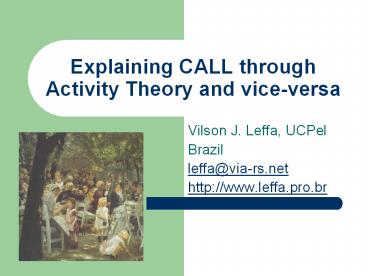Explaining CALL through Activity Theory and vice-versa - PowerPoint PPT Presentation
1 / 25
Title:
Explaining CALL through Activity Theory and vice-versa
Description:
No 'reliable conceptual framework' (Levy, 1997, p. 3) ... No piano sonata without a piano. Simulation hypothesis. Internalization and ZPD ... – PowerPoint PPT presentation
Number of Views:27
Avg rating:3.0/5.0
Title: Explaining CALL through Activity Theory and vice-versa
1
Explaining CALL through Activity Theory and
vice-versa
- Vilson J. Leffa, UCPel
- Brazil
- leffa_at_via-rs.net
- http//www.leffa.pro.br
2
Main points
- Need for a unifying theory in CALL
- Introduction to Activity Theory (AT)
- Structure
- Principles
- Hierarchical levels
- Merging AT with CALL
- A new paradigm in CALL research?
3
Need for a unifying theory in CALL
- Many nos
- No reliable conceptual framework (Levy, 1997,
p. 3) - No recognition as an area of research (Keegan,
1990, p. 51) - No unifying theory (Holmberg, 1982 Kelly, 1990
Smith, 1980) - The tutor/tool dichotomy
- Challenge How to incorporate opposites and
- fragments into a unified theory
4
Activity Theory (AT)
- AT is a philosophical and cross-disciplinary
framework for studying different forms of human
practices as developmental processes (Kuutti
1996) - Historical materialism
- HCI Hospitals Schools
- Social practices
- Development
5
Structure
- Segmentation for explanatory purposes
- How does the subject appropriate the object?
6
Mediation
- A tool
- empowers the subject
- materializes an object
- imposes limitations
- modifies the subject
- cannot be discarded
7
Object - Outcome
- Object
- Content to be internalized
- Outcome
- Content actually internalized
- Possible conflicts
- Phases of the Moon
- Teachers expectation Versus students
realizations
8
Contextualization
- The immersion process
- Vulnerability
- Inside / outside
- Distributed cognition
- Part of a whole
9
The whole picture
10
Principles
- object-orientedness
- mediation
- development
- internalization/externalization
- unity of consciousness and activity
- contextualization
- hierarchical structure
11
Object-orientedness
- The object may be
- physical, chemical, biological, social, cultural
- may involve
- feelings, ideas
- colonialism, brotherhood
- but always treated as objective reality
12
Principle of mediation
- Tools as extension of our organs
- Tool organ functional organ
- Transmission of knowledge
- Accumulation of knowledge
- We need more than our hands and our mind to learn
and change we also need the tools we have
created (Bacon)
13
Principle of development
- AT develops continuously
- Supports fast methodological updates
- Requires a view of historical development
- Does not allow re-inventing the wheel
14
Internalization/externalization
- No boundary between what is inside and what is
outside - Activities are externalized on objects
- Objects may be indispensable
- No piano sonata without a piano
- Simulation hypothesis
- Internalization and ZPD
15
Hierarchical levels
(Harris)
16
A CALL activity
- If AT did not exist we would have to invent it to
explain CALL - AT can account for the diversified nature of CALL
- Any component in the structure can be replaced
- AT can account for the historical development of
CALL - Any theory is seen as part of an evolutionary
process
17
Freezing a moment
18
Structure
19
The tool issue
- Beyond computer
- Screen is not a sheet of paper
- Undue emphasis on technology?
- Demands on the user
- The tutor/tool dichotomy
20
Object-oriented
- A beater in a primeval collective hunt,
frightens a herd of animals and sends them
toward other hunters, hiding in ambush.
(Leontyev, 1981 209-210). - Sometimes a students action does not coincide
with the final objective - Importance of consciousness
21
Tool mediation
- Any piece of courseware ... carries with it a
teacher in the machine, a projection of the
personalities of the designers, programmers,
materials developers (Hubard, 1996 21) - People anthropomorphize computers, treating the
machine as if it were a person (Schaumburg, 2001
Reeves Nass, 1996)
22
Externalization/ Internalization cycle
- We externalize what is inside us through words
and gestures - Words and gestures can be saved and reproduced
- Images, movement, and interactivity can be added
to amplify our gestures - Under certain conditions (ZPD etc.) what is
externalized can be internalized
23
CALL is dynamic
- Computers change continuously, requiring
activities to be developed and re-developed - Computers facilitate change
24
The hierarchical issue
- Operation level (below consciousness)
- Typing skills
- Eye-hand synchronization
- Action level (conscious)
- Answering a question
- Activity level
- Cloze
- Chat session
25
Final comments
- AT as a simple and visual way to explain the
complexity of situated CALL - We learn and change through the instruments we
create - Playing with different identities
- Possibility of starting a new research paradigm
if all lose ends in CALL are put together































